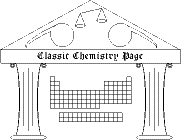Ramsay radon
The rightmost column of the periodic table, that of the noble gases, was put there largely through the efforts of William Ramsay. He had a part in the discovery of argon, the identification of helium on earth[1], the proposal that argon and helium belonged in a new column of the periodic table, and the discovery of krypton, neon, and xenon to fill that column. Ramsay even had a hand in establishing the atomic weight of the noble gas radon, the subject of this exercise.
Ramsay and Robert Whytlaw Gray built a balance sensitive to half of a millionth of a milligram. They reported the data shown below on the density of the "emanation of radium," as the gas was then known. Volumes are in units of thousandths of a cubic millimeter, and they refer to conditions of 0°C and 1 atm. Masses are in units of millionths of a milligram.
| sample | volume | mass
|
| I | 72.8 | 722
|
| II | 58.5 | 564
|
| III | 58.5 | 577
|
| IV | 67.7 | 658
|
| V | 73.0 | 706
|
Use the ideal gas law to compute the molar mass of each sample and report the mean and standard deviation of the molar mass. (Hint: remember that a liter is defined as a decimeter cubed.)
Reference
William Ramsay & Robert Whytlaw Gray, "Density of the emanation of radium," Comptes Rendus 151, 126-8 (1910).
[1]It had previously been known only in the sun, from its spectrum.
Copyright 2003 by Carmen Giunta. Permission is granted to reproduce for non-commercial educational purposes.

| Back to the top of the Classic Chemistry site |